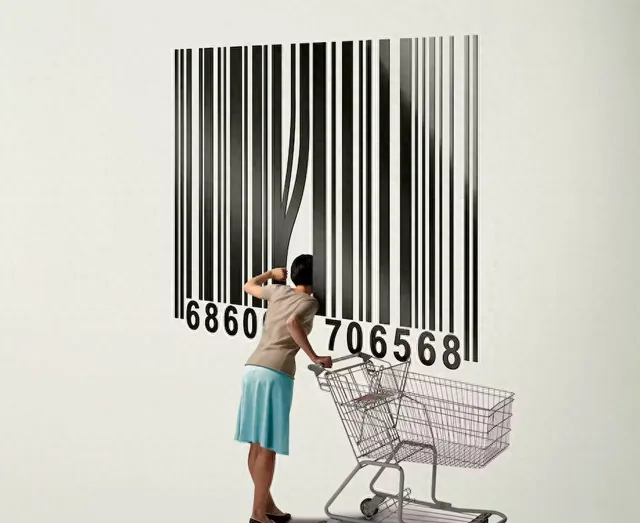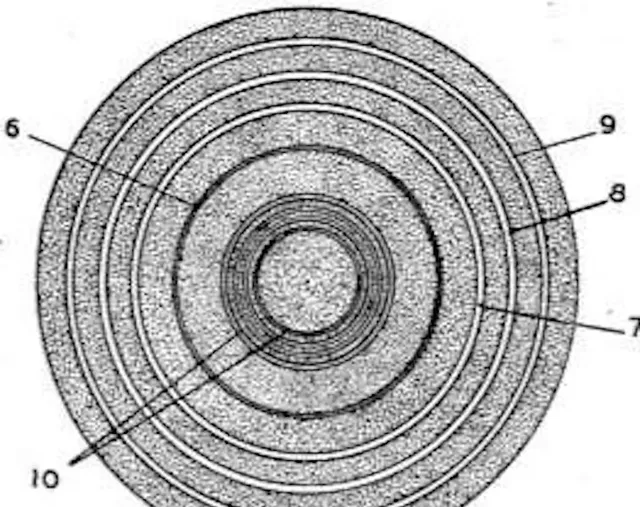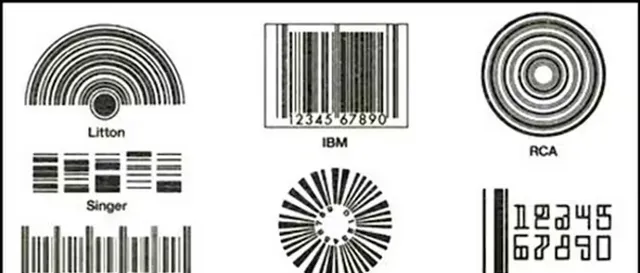
Few objects in the world are more immediately recognizable than the bar code. After all, bar codes are all around us. They're on the books we buy and the packages that land on our doorsteps. More than 6 billion bar codes are scanned every single day. They've become such an accepted part of our daily lives that it's hard to imagine how they could look any different.
世界上很少有比條形碼更容易辨識的物品了。畢竟,條形碼就在我們身邊。我們買的書上有,我們家門口的包裹上也有。每天掃描的條形碼超過 60 億個。條形碼已經成為我們日常生活的一部份,很難想象它們會有什麽不同。
I've researched various technologies throughout my career as a media studies professor, but it wasn't until I began writing my book about the cultural history of the bar code that I realized how even the most mundane objects in our lives look the way they do because of decisions that are mostly lost to history. When I began combing through the archive of bar code history at Stony Brook University, I realized just how close we came to a world where we scan bull's-eye or Sun symbols to buy our groceries.
作為一名媒體研究教授,我在整個職業生涯中都在研究各種技術,但直到我開始撰寫關於條形碼文化史的書時,我才意識到,即使是我們生活中最普通的物品,它們之所以會變成現在這個樣子,也是由於那些大多已被歷史遺忘的決定。當我開始梳理石溪大學的條形碼歷史檔案時,我意識到我們離掃描牛眼或太陽符號來購買雜貨的世界有多近。
Our story begins in 1949, when Joseph Woodland and Bernard Silver submitted a patent for the first bar code. That patent described the basic structure of using pairs of lines to represent numbers that is still used in bar code technology more than 70 years later.
我們的故事始於 1949 年,當時約瑟夫-森林地和伯納德-西爾弗送出了第一份條形碼專利。該專利描述了使用成對的線條表示數位的基本結構,70 多年後的今天,條形碼技術仍在使用這種結構。

What their patent didn't include, however, was anything most people today would recognize as a bar code. In fact, the first bar code didn't include vertical lines at all. Instead, the world's first bar code used a series of concentric circles in the shape of a bull's-eye.
然而,他們的專利並不包括任何今天大多數人都能辨識的條形碼。事實上,第一個條形碼根本不包括垂直線。相反,世界上第一個條形碼使用了一系列牛眼形狀的同心圓。

Woodland and Silver initially struggled to get companies interested in their invention. But the bar code's fortunes began to change in 1960, when the engineer and physicist Theodore H. Maiman built the first working laser, which made it possible to quickly decode a bar code's line patterning.
森林地和西爾弗起初很難讓公司對他們的發明感興趣。但條形碼的命運在 1960 年開始發生變化,工程師兼物理學家狄奧多-H-邁曼制造出了第一台工作雷射器,從而可以快速解碼條形碼的線條圖案。
Not long afterward, in 1967, the railroad industry implemented Kartrak, which was the world's first official bar code system. Kartrak bar codes were developed to automatically identify rail cars as they moved past scanners, but they used a design of lines of varying colors that looks more like a piece of modern art than the bar codes we use today.
不久之後的 1967 年,鐵路行業開始使用 Kartrak,這是世界上第一個正式的條形碼系統。Kartrak 條形碼的開發是為了在鐵路車輛經過掃描器時自動辨識它們,但它們使用了不同顏色的線條設計,看起來更像是一件現代藝術品,而不是我們今天使用的條形碼。
But Kartrak struggled from the start – the system wasn't as accurate as people had hoped – and it stopped being used in the 1970s. Despite being the first bar code to be officially adopted by an industry, the multicolored design of the Kartrak symbol is now just a footnote in history.
但 Kartrak 從一開始就舉步維艱--該系統並不像人們希望的那樣精確,因此在 20 世紀 70 年代就停止使用了。盡管 Kartrak 是第一個被行業正式采用的條形碼,但它的多色符號設計現在只是歷史的一個註腳。
Around the same time Kartrak was launched, the grocery industry set in motion a chain of events that eventually resulted in the bar code we know today. In the late 1960s, various stores began bar code pilot projects that used vastly different types of bar code symbols.
大約在 Kartrak 推出的同時,零售業也開始了一連串的活動,最終形成了我們今天所熟知的條形碼。20 世紀 60 年代末,各種商店開始了條形碼試點計畫,使用的條形碼符號型別大相徑庭。
One of the symbols was the original bull's-eye bar code, which by that point was owned by RCA because it had purchased the patent rights. But other stores used symbols developed by other companies. For example, a company named Carecogn had developed a Sun symbol and the Litton company created a fan symbol that were part of pilot projects. The grocery industry soon realized that this Wild West period of experimentation couldn't last.
其中一個符號是最初的 "牛眼 "條形碼,由於 RCA 已購買了專利權,因此該條形碼歸 RCA 所有。但其他商店使用的是其他公司開發的符號。例如,一家名為 Carecogn 的公司開發了一種太陽符號,而 Litton 公司則創造了一種風扇符號,這些都是試點計畫的一部份。零售業很快就意識到,這種狂野的西部試驗期不可能持久。
Bar codes could work as a way to automate inventory and checkout only if everyone in the grocery industry agreed to use the same symbol. Otherwise, the system would be overly complex and expensive. So in 1971, the grocery industry formed a committee tasked with developing an industrywide data standard and choosing a symbol that stores would agree to adopt.
只有當零售業的每個人都同意使用相同的符號時,條形碼才能作為庫存和結賬自動化的一種方式發揮作用。否則,系統就會過於復雜和昂貴。因此,1971 年,零售業成立了一個委員會,負責制定全行業的數據標準,並選擇一個商店同意采用的符號。
The data standard the committee developed – the Universal Product Code – was designed to work with different types of bar code symbols. It's still in use 50 years later.
該委員會制定的數據標準--通用產品程式碼--旨在與不同型別的條形碼符號配合使用。50 年後,它仍在使用。
The committee then had to choose the symbol. They solicited applications from various companies and narrowed the pool down to seven finalists. That was when the drama really began.
然後,委員會必須選擇符號。他們向各家公司征集申請,最後篩選出七家入圍公司。戲劇性的一幕就此拉開序幕。

The RCA submission was the early leader among the seven finalists. The bull's-eye bar code, after all, was the original bar code symbol, and RCA was a powerful company that had invested significant resources in developing the technology. RCA's main competitor was a latecomer to the battle for bar code dominance: the IBM symbol invented in the early 1970s by George Laurier.
RCA 送出的方案在七家入圍公司中處於領先地位。畢竟,"牛眼 "條形碼是最初的條形碼符號,而 RCA 是一家實力雄厚的公司,在開發該技術方面投入了大量資源。RCA 的主要競爭對手是條形碼爭霸戰的後來者:喬治-勞裏埃在 20 世紀 70 年代初發明的 IBM 符號。
Between March 1971 and March 1973, the committee extensively tested the seven finalists, listened to pitches from each company and met multiple times to discuss the path forward. Throughout the process, RCA and IBM remained the front-runners, and in a somewhat ironic twist, Joseph Woodland – the 「father of the bar code」 and inventor of the bull's-eye symbol – advocated for the IBM symbol over his own invention.
從 1971 年 3 月到 1973 年 3 月,委員會對最終入圍的七家公司進行了廣泛的測試,聽取了每家公司的介紹,並多次開會討論未來的發展方向。在整個過程中,RCA 和 IBM 始終處於領先地位,而具有諷刺意味的是,"條形碼之父"、牛眼符號的發明者約瑟夫-森林地(Joseph Woodland)主張采用 IBM 的符號,而不是他自己的發明。
Realizing their symbol might not be selected, RCA began to pressure the committee and threatened to pull out of the bar code industry altogether if their bull's-eye bar code was not chosen as the industry standard.
RCA 意識到自己的符號可能會落選,於是開始向委員會施壓,並威脅說如果他們的牛眼條形碼不被選為行業標準,他們將徹底結束條形碼行業。
The committee's deadline to select a symbol was March 1973, and the decision went down to the wire. In its final meeting, the committee chose the IBM symbol despite concerns that, to quote the historian Stephen Brown, 「by opting for the oversquare symbol instead of the bulls-eye, the Committee may have dramatically slowed the pace of implementation」 because of RCA's pressure.
委員會選擇標誌的最後期限是 1973 年 3 月,決定是在最後一刻才做出的。在最後一次會議上,委員會選擇了 IBM 符號,盡管有人擔心,參照歷史學家史帝芬-布朗的話說,"由於 RCA 的壓力,委員會選擇了超方形符號而不是牛眼符號,這可能會大大延緩實施的步伐"。
The IBM symbol became the industry standard, and the very first Universal Product Code bar code was scanned at a grocery store in Troy, Ohio, on June 26, 1974. Rather remarkably, the IBM symbol the committee chose is still going strong almost 50 years later. The bar codes you scan at a grocery store are essentially the same bar codes someone would have scanned in the 1970s.
IBM 符號成了行業標準,1974 年 6 月 26 日,俄亥俄州特洛伊市的一家雜貨店掃描了第一個通用產品程式碼條形碼。令人驚訝的是,委員會選擇的 IBM 符號在將近 50 年後的今天仍在繼續使用。您在雜貨店掃描的條形碼與 20 世紀 70 年代人們掃描的條形碼基本相同。
Based on meeting notes from the symbol selection meetings, the committee members felt they were doing important work. But even in their wildest dreams, they could not have imagined how consequential their decision ended up being.
根據符號選擇會議的會議記錄,委員會成員認為他們所做的工作非常重要。但即使在他們最瘋狂的夢想中,他們也無法想象他們的決定最終會產生多大的影響。
The bar code design they selected became one of the most iconic images of capitalism and has inspired architects' building designs, symbolized dystopian conformity in science fiction, become a popular tattoo and even inspired online fan communities.
他們選出的條形碼設計成為資本主義最具標誌性的形象之一,激發了建築師的建築設計靈感,在科幻小說中象征著烏托邦式的順從,成為一種流行的紋身,甚至激發了網路粉絲社群的靈感。
But the design that changed the world came remarkably close to being a forgotten piece of history. If a few grocery executives had voted a different way, we might be moving through a world filled with bull's-eyes.
但是,這個改變了世界的設計卻差一點成為被遺忘的歷史。如果當時有幾位雜貨店高管投了不一樣的票,我們可能就會在一個充滿牛眼的世界裏穿梭。











